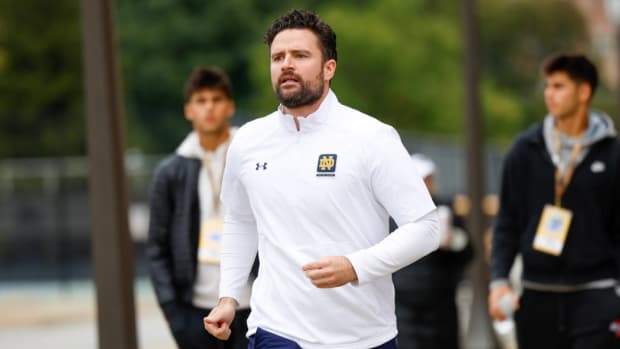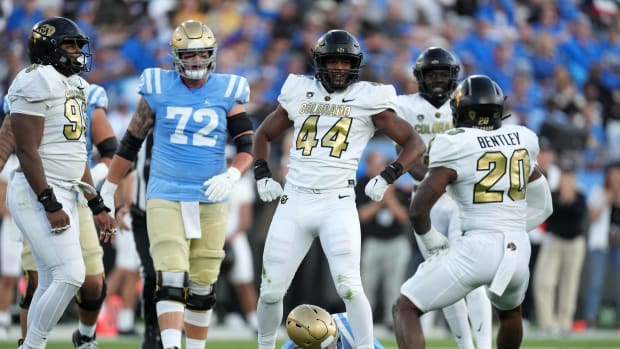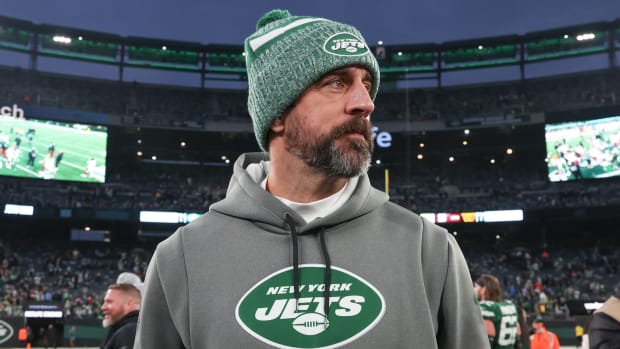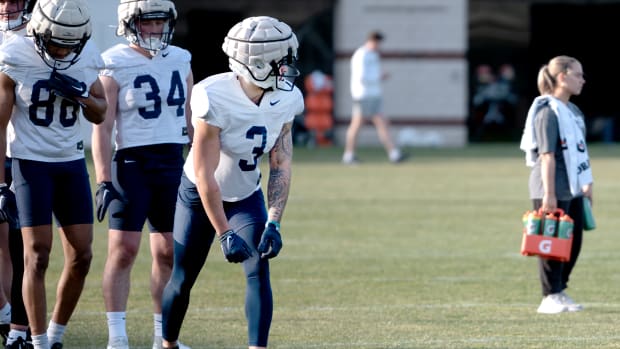This story is part of Sports Illustrated’s exploration of the ways sports and finance intertwine—from the NIL revolution to online betting, business-minded athletes and more. For more on sports and money, see SI’s October 2023 Money Issue.
NIL has made Michigan players richer, of course. It has also made the program better. Rather than fraying the team’s culture, NIL has reinforced it. In the past two years, the Wolverines have played harder, with a hyperfocus on team performance. They have grown closer. Their bonds with one another and the fan base have strengthened.
Since the Supreme Court ruling, Michigan has won back-to-back Big Ten championships and earned berths in the past two College Football Playoffs. It has done so by fitting a blue-collar approach into a flash-and-cash era. The best players get the most playing time and the most endorsement money. Seniors show freshmen how to succeed in the Big Ten and in marketing. Stars look out for the lesser-known. The offense is built around a power run game, players routinely outperform their recruiting rankings and, while individuals can make big money, the team still comes first.
A school that was reluctant to dive into the NIL world has thrived in it—thanks in part to a star who recognizes who benefits from the system and who doesn’t.
Blake Corum was a rising sophomore when the U.S. Supreme Court issued its ruling in NCAA v. Alston in June 2021. He did the math quickly. “The way I look at NIL—for our team, and just in general—is: Usually the most marketable guys are the guys that are scoring the touchdowns, right?” the running back says. “When NIL kicked off, I’m like, ‘All right, I’m gonna have a great chance because I’m the one scoring.’ ”
Corum has scored 31 touchdowns since Alston came down. Now, after rushing for 952 and 1,463 yards in the past two seasons, he is a Heisman candidate with a growing investment portfolio. He bought two rental properties in his home state of Virginia and invested in an apartment complex in Michigan to “make sure I have that cash flow coming in on a regular basis.” As he points out: “A lot of kids leave college, and they don’t have any money. They just have debt.”
Corum has struck at least a dozen NIL deals, including partnerships with Bose, Subway, the National Guard and Wolverine boots. He blends the pragmatism of a smart businessperson with the idealism of a college student. He declines to share his exact income but says he is in “the 1 percent”—a nod to the Occupy Wall Street movement and an indication that he has income inequality on his mind. (A Michigan resident would need to earn roughly $480,000 to be in the top 1% of state earners.) He raises money for various charities and donated 300 turkeys to local families last Thanksgiving.
Corum’s reaction to the NIL revolution two years ago was correct. And yet, what really separates him is his second thought: A system that rewards the guys who score touchdowns could neglect the guys who don’t. “I understood it right away,” Corum says. “You watch the commercials with NFL players; it’s always quarterbacks. You might get Marshawn Lynch here and there. You never see the offensive line. You really hardly ever see defensive players, unless you’re a Jalen Ramsey or something.”
This perverts the economic values of modern football. The NFL no longer sees star running backs as an essential component of winning. The current franchise-tag value for the position, $10.09 million, is the lowest in the sport outside of kickers and punters; the tag number for offensive linemen is $18.24 million. In a pay-for-play system with a salary cap, Michigan would devote heavy resources to its offensive line, which has won back-to-back Joe Moore Awards as the nation’s best. But NIL is based not on gridiron analytics but on celebrity, marketability and visibility—generally not core attributes of those who toil on the O-line. And so Corum’s earnings potential in college football far surpasses that of his linemen.
That is the kind of conflict some coaches feared. But Michigan guard Trevor Keegan says, “Blake is probably the most down-to-earth, least selfish human being I’ve ever met.” Sometimes Corum uses his stature to redirect business: “If a deal comes to me and I say, ‘I don’t want that deal,’ I might ask [for] someone else: ‘Hey, would it be possible if I asked him? Can he have the deal?’ I try my best to help some other guys put some cheese in their pocket.”
Last December, Corum and fellow running back Donovan Edwards (who has had deals with NASCAR and his own NFT) each left cash gifts for the offensive linemen in their lockers. Quarterback J.J. McCarthy (Bose, Dunkin’ and Topps, among others) gave them AirPods Max headphones, which retail for $500. But Corum says he generally does not hand money to teammates: “I don’t say, ‘Here’s $1,000.’ ” As Keegan says, “I don’t think many guys on the team would be comfortable with that.”
Corum prefers a more polished form of largesse: “If we’re out, I’ll put my card out: Y’all care if I pay?” Yes, picking up the tab is a new form of leadership in college sports. With one tap of his credit card, Corum eases the financial burden on his teammates, shows them he is a team player and provides an example of what they can become, with a caveat.
“You have to work for it,” Corum says of NIL money at Michigan. “Nothing’s given. Nothing’s handed out. And I think that’s the way it should be.”
The NIL era has gone so well for Michigan football in part because it started so slowly. After the Alston ruling, with little guidance from the NCAA, Michigan was extremely cautious (in the school’s telling) or flat-footed (in critics’ minds).
There were widespread, mostly unconfirmed rumors of schools luring recruits with massive NIL deals, notably when Alabama coach Nick Saban said Texas A&M “bought every player on their team.” (Saban later apologized.) Michigan’s administration was so wary of NIL deals being used as a recruiting inducement that the school took almost a year to announce it would officially embrace the fundraising collectives that had sprouted up around the country.
This approach may have cost Michigan in recruiting. But it helped avoid friction with players who were already in Ann Arbor. “My initial worry probably was that you pay a freshman that just came in a bunch of money coming out of school, and you got juniors and seniors that have been here, actually playing, who didn’t get anything,” right guard Zak Zinter says. “But luckily, and thankfully, Michigan took a different approach and didn’t really do it that way.”
Like most traditional powerhouses, Michigan has long taken pride in making freshmen earn their way to the top. Paying them up front, through NIL deals or under-the-table payments, can improve a team’s talent pool, but it causes other problems. It can make older players resentful, just as NFL veterans bristle when an untested draft pick signs a massive first contract. It’s also against NCAA rules to make NIL commitments as part of the recruiting process. That means most NIL promises are oral and unspecific, not written, so nobody gets caught—and that means the promises are not enforceable.
“I have a lot of friends from different schools and different programs where they’re getting promised money up front, whether it’s the [transfer] portal or in recruiting, and when they get to the program, they’re just not getting what they were told,” Keegan says. “That’s causing a lot of problems in other locker rooms.”
Corum says he has friends at other schools who tell similar stories: “They’d never signed anything, so therefore, they didn’t get it.” Those programs end up with upperclassmen who feel unappreciated and newcomers who feel stiffed. In an era of rampant player movement, those teams can implode quickly.
If NIL is primarily a way for the most successful athletes to capitalize on their achievements, though, then it enhances a team’s competitive culture. For a century, coaches have promised kids that if they worked hard, stayed out of trouble and kept their grades up, they would ultimately be rewarded—in school, in the pros or in life. But it took years for players to reach those pots of gold. NIL shrinks the rainbow. Elite college athletes have money to gain or lose every day.
Time spent consummating NIL deals can absolutely distract players from academics. But NIL could still ultimately improve graduation rates for athletes. Among the general population, students from low-income backgrounds are far more likely to drop out of college than those from high-income families; allowing athletes to earn money beyond their scholarships could keep them in school longer.
It also helps make teams better. In January, Valiant Management Group, which works with Corum, launched the One More Year Fund, an athletic- department-sanctioned collective that crowdsources donations for an NIL fund intended to keep Michigan athletes from leaving before their eligibility expires. Without NIL, Corum probably would have left for the NFL last year. He then likely would have left school to train for the draft, as most pro prospects do. Instead, he stayed and walked with Michigan’s spring 2023 graduating class; he is getting his final few credits for a sports management degree this fall.
Corum says NIL “gives you the freedom to make the choice you want to make.” Keegan decided after Michigan’s CFP semifinal loss last December that “I didn’t want my last game to be against TCU. It just didn’t feel right just to leave on that bad of a term. And I still want to do some things individually as well.”
He thinks he would have gone somewhere between the late-third and sixth rounds of the draft. But he says, “From the Big Ten championship to the bowl game I think I made like around $50 [thousand] to $70,000 that month alone.” He opted to stay at Michigan and is pursuing a graduate degree in the School of Social Work.
Keegan was the 184th-ranked recruit in the country. He plays left guard. He is nobody’s marketing dream and he knows it: “I’m not much of a poster on social media, and there’s been a lot of companies that reached out and asked me to post a lot. It’d be like making Reels and stuff, being creative, making TikToks. And that’s just not who I am. I’m not good at that kind of stuff. I think it’s kind of cringey, too.” Yet Keegan expects to make “anywhere from $225 [thousand] to half a million” in NIL money this year. The system that enriches Blake Corum is taking care of Trevor Keegan, too.
Nobody knows how long Michigan can maintain this symbiosis between NIL opportunities and CFP dreams. But for now it’s working incredibly well. Keegan says when a bunch of Wolverines did a shoot for Wolverine boots this summer, it was “kind of like a bonding thing as well.”
Last year Corum got hurt late in the season, then watched his replacement, Edwards, run for 520 yards in three games. That could have created tension over carries—and the NIL dollars that could follow them. Instead, Corum refers to Edwards as “a great friend, a brother.” They have done joint autograph signings and have talked about building low-income housing together someday. But tell the suits and coaches not to worry: That’s just a far-off dream. Right now, they’re focused on the season.







